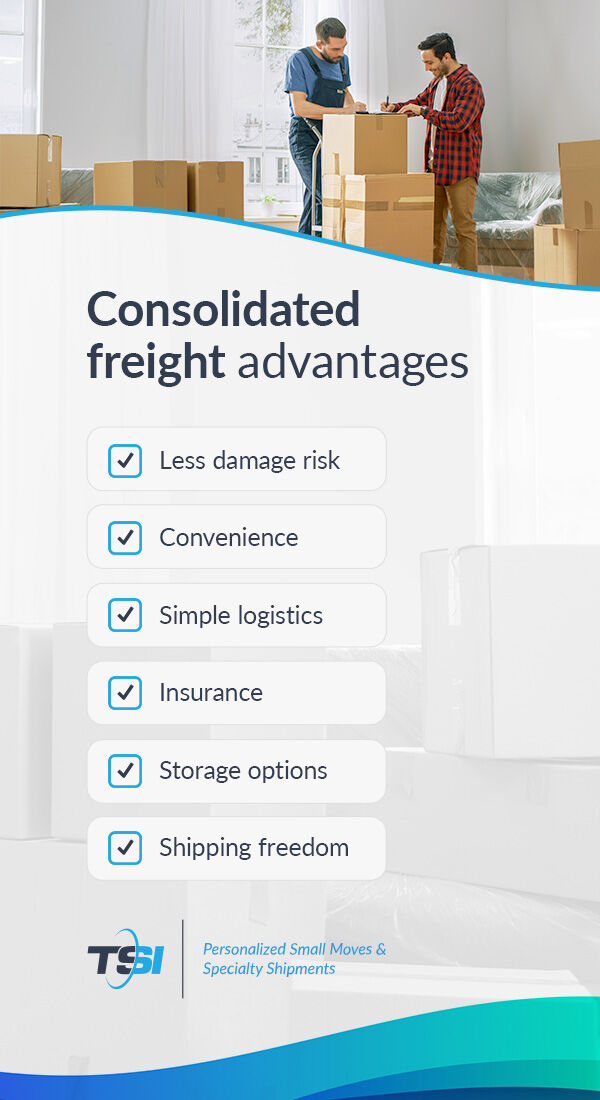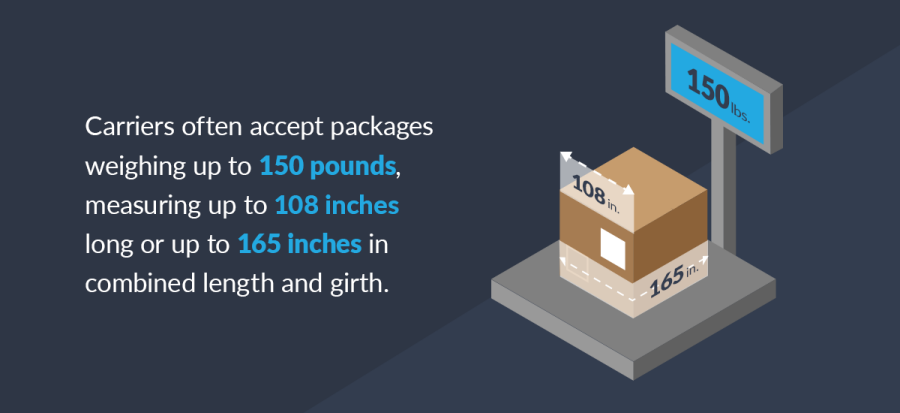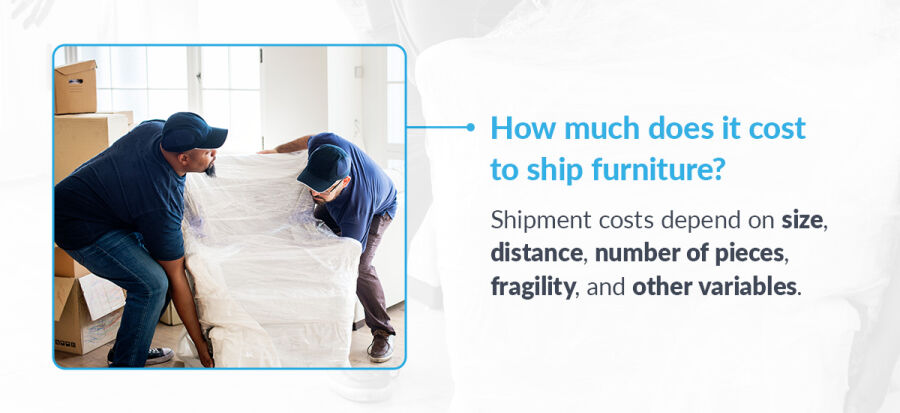Mailing or shipping small boxes is often as easy as dropping packages off at your local post office or courier. Shipping large boxes is a little more complicated. The United States Postal Service (USPS) and courier services have strict weight and size limits. These methods can become expensive for large packages, especially if you have heavy boxes or plan to ship them long distances.
Business owners sending packages to customers or homeowners moving house need to know the best way to ship large boxes. This comprehensive guide explores methods of shipping large boxes across the country. Use the menu to jump straight to the section you need!
How to ship large items across the country
You have four options to ship large packages:
- Consolidated freight
- U.S. Postal Service (USPS)
- Courier shipping (UPS®, FedEx®)
- Rent a truck and move yourself
Knowing the size and weight of your box helps you narrow down your shipping options. You can calculate the dimensions of a box by measuring three elements:
- Length: A box's length is its longest side, including a flap.
- Width: This is the shortest side of the box with a flap.
- Height: A box's height or depth has no flap. You measure this from the top down to the bottom of the box.
Length x width x height (L x W x H) = total size of box
USPS has weight and size limits on packages. Consider courier services like FedEx or UPS to ship packages between 70 and 150 pounds. You must ship anything over 150 pounds by freight.
Let’s take a closer look at each of the different shipping methods:
1. Consolidated freight
With consolidated freight shipping, your boxes join others heading in the same direction on a single truck. Reputable providers connect you with licensed and insured shipping companies that provide these services.
Consolidated freight companies may offer additional services, such as:
- Temperature-controlled vehicles for perishable or delicate goods.
- Loading and unloading by hand (instead of by forklift) to protect fragile items.
- Value-added services, such as professional packing or expedited timing.
Consolidated freight shippers offer two service levels:
- Less than truckload (LTL) or economy: Choose this option if your items don't require a full truckload. The provider helps with curbside loading and unloading, but you pack your boxes yourself. Prices depend on the weight and number of boxes. With lower prices and faster delivery, LTL is ideal for less fragile or valuable items.
- White glove: This premium service includes indoor pickup and delivery. Providers may avoid using heavy machinery like forklifts to move boxes, decreasing damage risk for fragile or valuable items. However, delivery time frames are much longer. This level of service is more expensive than LTL or economy.
LTL shipping suits shipments of more than 15 boxes. Pallet shipping packs boxes on a pallet for extra security and ensures your boxes stay together throughout the journey.
Shipping less than 15 boxes?
You need TSI’s box-and-ship program. We deliver the boxes and labels to your door so you can pack them yourself. Once ready, we return to pick them up and deliver them anywhere across the country.
Ideal for: Clothes and linens, books, non-valuable household goods
The number of boxes you send determines TSI's flat-rate shipping costs. Learn more about TSI’s Box-and-Ship Program.

Consolidated freight advantages:
- Less damage risk: You can trust experienced professionals to handle your boxes with care.
- Convenience: Make the most of the space in your rented moving vehicle, free of large boxes.
- Simple logistics: Easy-to-coordinate pickup and delivery.
- Insurance: Providers include basic insurance.
- Storage options: Some shipping companies offer temporary storage.
- Shipping freedom: Consolidated freight shipping has no weight or size limits.
Consolidated freight disadvantages:
- Extended timelines: Delivery may take longer unless you pay for expedited shipping.
- Excluded services: Some consolidated freight providers may not include packing and loading services.
How much does it cost to ship large boxes using consolidated freight?
The cost of shipping boxes using consolidated freight depends on the level of service you choose and the number of boxes you are shipping. Contact your local provider to find out their rates.
When should I use consolidated freight to move my large boxes?
Consolidated freight suits the following scenarios:
- Larger household moves
- Long-distance moves
- Shipments of any size
- Assistance with packing or crating
2. United States Postal Service (USPS)
The USPS offers several service levels suitable for large boxes up to 20 inches long by 14 inches wide and 10 inches deep:
Priority Mail
Priority Mail packages ship in 1-3 business days, depending on the origin and destination. USPS has a weight limit of 70 pounds for packages with a maximum combined length and width of 108 inches. Flat-rate pricing saves you from weighing or calculating costs for sending packages under 70 pounds. The fee includes shipping supplies. Retail outlets offer regional and prepaid pricing if you want to use your own boxes.
Priority Mail Express
Priority Mail Express typically ships in 1-2 business days. You can pay an extra fee for guaranteed overnight delivery, but the only way to ensure same-day shipping is to drop it off at the post office instead of scheduling a pickup. Similar to Priority Mail, packages must weigh less than 70 pounds.
Priority Mail Express is a popular business choice that can streamline payments by charging all overnight shipments to one account.
USPS Retail Ground
USPS Retail Ground is only available at the post office. USPS Ground uses a tiered pricing system based on your box's size, weight, and shape. This service is ideal for less-than-urgent deliveries and oversized packages that are too large for Priority Mail or Priority Mail Express. The maximum weight for USPS Retail Ground shipments is also 70 pounds, but boxes can be up to 130 inches in combined length and width. These packages may be subject to oversized pricing.
USPS advantages:
- Online services: You can set up most services online.
- Cost-effective: USPS may be cheaper than other shipping methods.
- Free pickup: You may qualify for free collection depending on the service level.
- Insurance: Shipping includes basic insurance, depending on the service level.
- Overnight delivery: You can pay an extra fee for next-day delivery.
- International shipping: USPS offers international delivery services.
USPS disadvantages:
- Weight restrictions: USPS is unsuitable for boxes over 70 pounds.
- Size limits: Large, lightweight packages incur oversized pricing.
- Timing: These services are the least reliable for time-sensitive shipments.
- Insurance fees: You may need to purchase additional insurance for high-value packages.
- Limited tracking: USPS' tracking services aren't available for all packages and are less detailed than courier service.
When to ship large boxes using the USPS
Ship large boxes with the USPS in these cases:
- Larger packages that meet the weight and size requirements.
- One-time shipments of single boxes.
- Businesses with recurring shipments.
- Non-urgent timelines.
3. Courier shipping for large boxes

Familiar names like FedEx®, UPS®, or DHL® provide courier shipping services. These carriers often accept packages weighing up to 150 pounds, measuring up to 108 inches long or up to 165 inches in combined length and girth. They can also transport oversized packages (subject to additional charges).
You can book express delivery and add packing services for an additional fee. Courier shipping is ideal for retailers shipping merchandise to customers or homeowners looking to ship a few time-sensitive boxes to a new home.
If you are considering courier services, you must familiarize yourself with “dimensional weight.” Courier companies price parcel shipments based on weight, but the space they take up on the truck also impacts the cost of your shipment, especially if you move bulkier items like large boxes. Dimensional weight better reflects a shipment's actual weight relative to the space it takes up.
How to calculate dimensional weight
Measure the package dimensions to calculate the cubic size in inches:
L x W x H = cubic size
To determine the dimensional weight, divide the cubic size by the dimensional weight divisor from your parcel shipping service. If in doubt, ask your shipping provider for this information.
Courier advantages:
- Faster shipping: You can pay for expedited shipping.
- Reliability: Courier services are more reliable for time-sensitive shipments than USPS.
- Added services: Choose professional packing and crating at an extra fee.
- Insurance: Courier companies offer additional insurance at a cost.
- Bulk discounts: Volume shippers, such as retailers, may be able to negotiate discounts.
Courier disadvantages:
- Pickup limitations: You may have to take your boxes to a store to ship them.
- Higher cost: Shipping oversized boxes or boxes over 150 pounds can become expensive.
- Added fees: Time-sensitive shipments can incur extra costs.
- Less control: You have little oversight of your boxes between pickup and delivery.
- Limited insurance: Basic insurance may be insufficient for your needs.
How much does it cost to ship large boxes using courier shipping services?
The cost of courier shipping depends on the level of service you choose and the distance your package travels. Regardless of how you pack them, next-day or expedited shipments cost more than regular ground freight.
Courier shipping is often cheaper than USPS Priority Mail, as it has a longer delivery window. However, USPS Priority Mail is more affordable for shipments under 5 pounds using a flat-rate large box. For shipments over 5 pounds, it's better to use courier services.
When to ship large boxes using courier services
The following situations suit courier shipping:
- One-time shipments
- Retailers shipping small purchases to customers
- Homeowners shipping less than five large boxes
- Packages between 70 and 150 pounds
- Packages larger than 108 inches but smaller than 165 inches
- Same-day or next-day deliveries
4. Rent a truck and move yourself
If you want to transport large boxes as part of a household move, you can rent a truck and move them yourself.
Renting a moving truck and transporting your belongings is popular for small or short-distance moves. This method suits smaller, short-distance moves where you can load and unload your belongings without help.
How to load large boxes onto the moving vehicle
Strategic loading can help maximize your truck space and minimize the work you must do. Follow these tips:
- Use the proper technique to lift boxes. Bend and lift from your legs, not from your back.
- Start by loading large, heavy appliances, then load longer items like couches or beds.
- Load boxes after large furniture items. Secure the boxes in place and avoid loading anything too heavy on top.
- Place boxes in layers, securing each layer independently as best as possible.
- Put heavier boxes on the bottom and load lighter boxes on top.
- Drape blankets over exposed surfaces to protect them from scratches or other damage.
Self-move advantages:
- Budget-friendly: Moving yourself is often cheaper than hiring professional movers.
- Oversight: Your belongings remain in your care the entire time.
- Freedom: You can move on your timeline.
Self-move disadvantages:
- No assistance: You must pack and load boxes yourself.
- Injuries: Larger boxes can be challenging to lift and move.
- Safety risks: Packing belongings in the back of a hot or cold truck can be dangerous.
- Unsuitable for long distances: Renting a truck can be expensive for long-distance moves, particularly if you move a lot of stuff.
- Lack of insurance: Truck rental excludes belongings insurance.
How much does it cost to rent a truck and move large boxes?
The size of the vehicle and the distance of your move determine the cost of moving with a rental truck. In addition to the size-based daily rate, you must cover fuel and mileage charges. Also, consider the costs of moving supplies and insurance. If moving long-distance, you may need to pay extra to leave the truck in a different city than where you picked it up.
When should I rent a truck and move my boxes?
Renting a truck makes sense for a local or short-distance move when the budget is a higher priority than time.
How do I ship large items like furniture?

Because of their irregular size, shipping furniture can be a bit trickier than shipping boxes because of their irregular size. Many moving companies require a minimum weight. They may charge the full rate or refuse the job for small moves of less than 3,500 pounds. Shipping furniture can be expensive, and most people underestimate the cost.
The recommended way to ship furniture depends on how soon you need it. If your timing is flexible, you can take advantage of consolidated shipping, which is more cost-effective but takes longer to arrive. Priority or scheduled shipping costs more. Consolidated freight is often the best option since it combines loads to save money.
TSI offers the following furniture shipping options:
- White glove consolidated: Our professionals prepare, pick up, and deliver your furniture. This service includes limited liability coverage. Our White Glove option works best for long-distance shipping when time is not a concern.
- Full service expedited: Choose our expedited service for faster delivery or an entire home's worth of items. You enjoy full-service professional packing, pickup, and speedier delivery. We also include full valuation protection insurance.
How much does it cost to ship furniture?
Shipment costs depend on size, distance, number of pieces, fragility, and other variables. When shipping furniture, consider whether the shipping price exceeds the item's value. Buying new furniture may be more cost-effective unless the piece has sentimental or high financial value. Remember, you can combine items into one shipment for the same price. TSI's minimum weight is 120 pounds, so you pay the same price whether you send one chair or many.
Recommended shipping methods
For long-distance or more significant household moves, we recommend consolidated freight. Consolidated freight companies pre-vet carriers and check licenses so you can rest assured of the safe transport of your boxes.
A rented moving truck may be the most cost-effective option for small or short-distance moves.
The top consolidated freight providers offer personalized shipping services tailored to your cargo. Custom plans include providing boxes, supplies, or packing assistance. They also connect you with a shipping company specializing in transporting your items. You can select a service level based on your needs, from lower-cost LTL to premium White Glove Service.
Special considerations for shipping large boxes
What exactly is a “large” box? A standard large box is about the size of a large suitcase. The most common size is 18 inches by 18 inches by 24 inches. You can find larger or even extra-large boxes measuring up to 24 inches long and 18 inches wide.
Large boxes suit bulky, lightweight items such as:
- Lampshades
- Stereo speakers
- Board games
- Pillows
- Clothing
- Towels and linens
- Shoes
- Small appliances
With adequate padding and proper packing, you can ship anything in a large box, including heavier or delicate items. Check the weight limit on the bottom of any large boxes. Some boxes may have a lower weight limit than you might expect.
Packing large boxes is more than simply loading everything into the box and taping it shut. Keep these considerations in mind when you pack:
Weight
Large boxes should be full but not heavy. If possible, they should not exceed 50 pounds so that you can move them without serious risk of injury, especially if you need to lift them yourself. When boxes are too heavy, the risk of damage increases. Check the weight limit on the bottom of the moving box to avoid exceeding its maximum weight.
Size
Your box should be slightly larger than what you put inside it to allow space for enough packing materials to prevent shifting and breakage. When in doubt, use a larger box and ensure proper packing and padding.
Number of boxes
The more boxes you have to ship, the more your shipment costs. Depending on their weight, courier or postal services are best for single large box shipments, depending on their weight. Choose consolidated freight suits for delicate, valuable, or larger shipments of three or more boxes.
Contents of boxes
You must use the proper packing techniques to prevent shifting or damage from impact. Large boxes are ideal for light items that are easy to carry. Pack bulky but heavy items like books into smaller containers. The weight of these items adds up, making boxes hard to carry and increasing injury and damage risk. Opt for consolidated freight professionals to transport valuable, fragile, or antique items.
Insurance
Packing boxes yourself limits insurance options. Let the professionals pack your box if you ship delicate or high-value items. They will ensure the proper value and cover you in case of damage.
Double boxing
Double boxing, or packing a smaller box into a larger box, is ideal for shipping fragile or valuable items. After you pack the small box, layer packing materials into the bottom of a large box. Place the small box inside, then secure it using more packing materials.
Unboxing experience
Retailers can provide an enjoyable unboxing experience to ensure your customers have a satisfying encounter with your company. Use clean, new boxes rather than used boxes. Opt for bubble wrap or packing paper instead of packing peanuts, newspapers, or magazine pages.
Mistakes to avoid when shipping large boxes
Get your belongings to their destination in one piece by avoiding these errors:
- Overpacking: Just because you can fit 100 pounds of stuff into a box doesn’t mean you should. Moving and shipping boxes hold a certain amount of weight. Exceeding the recommended limit can strain or injure your back, and the box may tear or disintegrate. Overstuffed boxes can burst during a move.
- Improper padding: Line the bottom of the box with crumpled packing paper or bubble wrap, then pad the sides and around each object using the same materials as you fill the box.
- Packing the wrong items: Avoid placing items like food, liquids, and hazardous materials in boxes, especially if they stay in transit for long periods. However, you can pack fragile items like electronics or artwork into boxes if you wrap them.
- Incorrect lifting: Remember to lift with your legs and avoid twisting while you carry a large or heavy item. Use lifting aids like moving straps, dollies, and hand trucks.
- Shipping in used boxes: Used boxes can keep your moving or shipping costs low. While they suit less valuable or durable items, you should use new boxes for new or delicate belongings. Inspect used boxes for signs of damage. Use strong, dry, and damage and infestation-free boxes. You should also remove all old address labels. Retailers should never ship items to customers in used boxes. Used containers look unprofessional and may damage the contents.
- Unsuitable boxes: Some boxes, such as banker’s boxes, storage boxes, archive boxes, or copy paper boxes, are unfit for shipping. These boxes work for palletized transport. Reinforced boxes under 30 pounds may suit courier services. For heavier items, use double-walled corrugated boxes.
- Improper sealing: Use only high-quality packing tape. Avoid masking, duct, or painter’s tape for sealing boxes. Tape up all edges using the H-method and apply multiple layers of tape. Any untaped edge can be caught or torn in transit.
- Unlabelled boxes: If you are a retailer, fix the shipping label to the correct side to ensure it stays put. Avoid taping over the label to prevent scanning or legibility issues. For homeowners, label the top and at least one side of the box with what room it should go into.
How to pack large boxes
The key to safely transporting large boxes is to pack them the right way. Here’s how:
Packing materials
Your materials may be as important as how you pack the boxes. Invest in the following:
- Packing paper
- Bubble wrap (both large and small bubbles)
- Large boxes, preferably new
- High-quality packing tape
- Permanent marker
- Dolly or hand truck
Packing instructions
Now, it's time to wrap those items and pack that box:
- Assemble the box: Tape each seam on the bottom to create an H-shape.
- Measure the box: You need these measurements if you plan to ship your boxes using consolidated freight or to set up an online USPS or courier pickup.
- Line the box with padding: Crumpled-up newspaper or magazine pages can work for a household move, but packing paper is typically the best choice, especially for retailers. It provides the best unboxing experience and limits ink or dye transfer. Large bubble wrap also works well. Steer clear of packing peanuts that harm the environment and shift around inside the box.
- Wrap items individually: Wrap each item in packing paper before placing them into the box, especially if you are packing fragile items like dishware, frames, or glasses.
- Load heavy items first: Placing heavy items at the bottom of the box provides a solid base and prevents lighter items from getting crushed. Add a layer of padding on top of the heavy items, then continue packing lighter items. Padding around the edges of the box prevents shifting or impact damage.
- Add extra padding: If you have extra space at the top of the box, fill it with soft packing materials like towels or pillows, crumpled packing paper, or bubble wrap.
- Enclose contact details: Include the shipper and recipient’s address and phone number before sealing.
- Seal the box: Use the same H method you used when assembling the box. Take care to seal each seam with high-quality packing tape.
- Label the box: Always label special considerations such as “FRAGILE,” “THIS SIDE UP,” or “HEAVY.”
Why should you choose TSI to ship large boxes?
As small move and specialty shipment experts, TSI prides itself on finding the best way to ship large boxes. We offer an alternative to paying UPS or FedEx's oversized package fees. When you partner with TSI, you enjoy these benefits:
- Nationwide network: TSI has access to a network of box shipping experts. This partnership means we can get your large packages to the next state or even further.
- Palletized shipments: We can palletize shipments of 15 boxes or more for added safety.
- Professional packing: For extra peace of mind, choose a solution that includes our packing and unpacking services. We aim to deliver your belongings in the same condition they left!
- Customized plans: Let us tailor-make a moving plan to suit your unique needs. From custom crating to climate-controlled trucks, we can accommodate your requests.
- Insurance options: Full valuation protection covers the total value of your belongings.
Are you ready to make a move? Call us at 1-800-626-127 or request an online quote for your large box shipping needs!

